二十四节气英文介绍
- 格式:pdf
- 大小:54.23 MB
- 文档页数:82
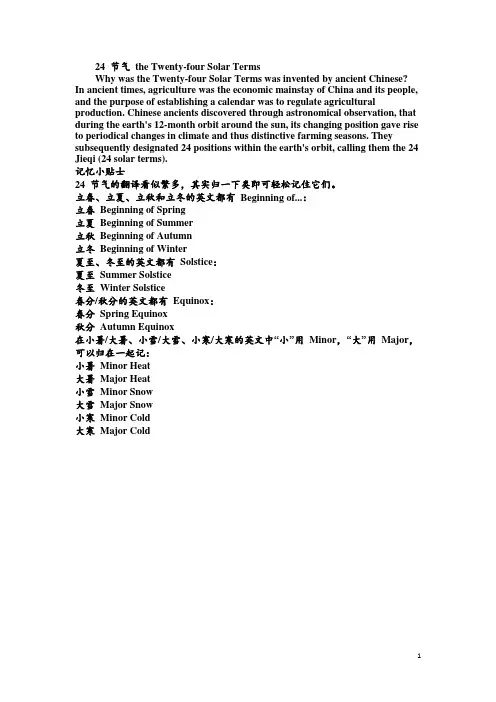
24 节气the Twenty-four Solar TermsWhy was the Twenty-four Solar Terms was invented by ancient Chinese? In ancient times, agriculture was the economic mainstay of China and its people, and the purpose of establishing a calendar was to regulate agricultural production. Chinese ancients discovered through astronomical observation, that during the earth's 12-month orbit around the sun, its changing position gave rise to periodical changes in climate and thus distinctive farming seasons. They subsequently designated 24 positions within the earth's orbit, calling them the 24 Jieqi (24 solar terms).记忆小贴士24 节气的翻译看似繁多,其实归一下类即可轻松记住它们。
立春、立夏、立秋和立冬的英文都有Beginning of...:立春Beginning of Spring立夏Beginning of Summer立秋Beginning of Autumn立冬Beginning of Winter夏至、冬至的英文都有Solstice:夏至Summer Solstice冬至Winter Solstice春分/秋分的英文都有Equinox:春分Spring Equinox秋分Autumn Equinox在小暑/大暑、小雪/大雪、小寒/大寒的英文中“小”用Minor,“大”用Major,可以归在一起记:小暑Minor Heat大暑Major Heat小雪Minor Snow大雪Major Snow小寒Minor Cold大寒Major Cold对于二十四节气,联合国教科文组织是这样介绍的:China—The Twenty-Four Solar Terms, knowledge of time and practices developed in China through observation of the sun’s annual motionThe ancient Chinese divided the sun’s annual circular motion into 24 segments, calling each segment a specific ‘Solar Term’. The criteria for its formulation were developed through the observation of changes of seasons, astronomy and other natural phenomena. The element remains of particular importance to farmers for guiding their practices. Some rituals and festivities are associated with the terms, which have contributed to the community’s cultural identity. Knowledge of the element is transmitted through formal and informal means of education.中国:二十四节气,中国人通过观察太阳周年运动而形成的时间知识体系及其实践中国古人通过观察太阳周年运动将太阳周年运动轨迹划分为24等份,每一等份为一个“节气”,统称“二十四节气”。
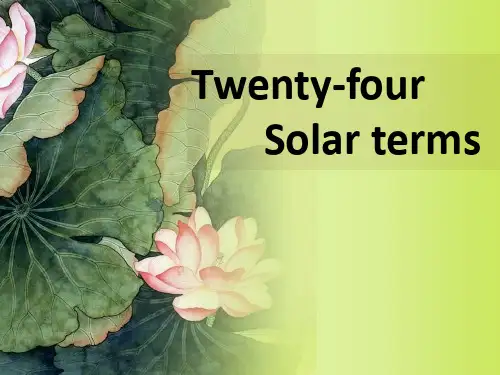
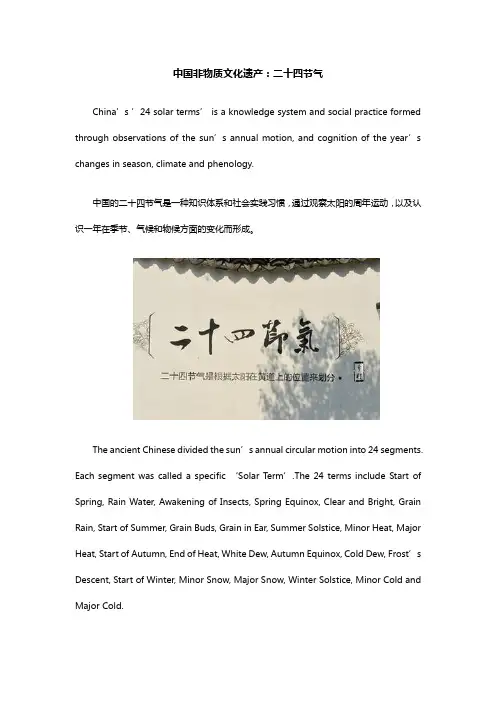
中国非物质文化遗产:二十四节气China’s ’24 solar terms’ is a knowledge system and social practice formed through observations of the sun’s annual motion, and cognition of the year’s changes in season, climate and phenology.中国的二十四节气是一种知识体系和社会实践习惯,通过观察太阳的周年运动,以及认识一年在季节、气候和物候方面的变化而形成。
The ancient Chinese divided the sun’s annual circular motion into 24 segments. Each segment was called a specific ‘Solar Term’.The 24 terms include Start of Spring, Rain Water, Awakening of Insects, Spring Equinox, Clear and Bright, Grain Rain, Start of Summer, Grain Buds, Grain in Ear, Summer Solstice, Minor Heat, Major Heat, Start of Autumn, End of Heat, White Dew, Autumn Equinox, Cold Dew, Frost’s Descent, Start of Winter, Minor Snow, Major Snow, Winter Solstice, Minor Cold and Major Cold.中国古人将太阳周年运动轨迹划分为24等份,每一等份为一个“节气”。
二十四节气包括立春、雨水、惊蛰、春分、清明、谷雨、立夏、小满、芒种、夏至、小暑、大暑、立秋、处暑、白露、秋分、寒露、霜降、立冬、小雪、大雪、冬至、小寒、大寒。
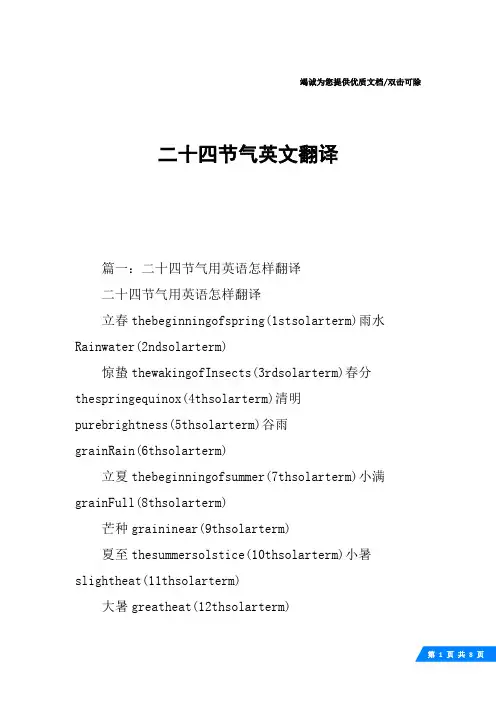
竭诚为您提供优质文档/双击可除二十四节气英文翻译篇一:二十四节气用英语怎样翻译二十四节气用英语怎样翻译立春thebeginningofspring(1stsolarterm)雨水Rainwater(2ndsolarterm)惊蛰thewakingofInsects(3rdsolarterm)春分thespringequinox(4thsolarterm)清明purebrightness(5thsolarterm)谷雨grainRain(6thsolarterm)立夏thebeginningofsummer(7thsolarterm)小满grainFull(8thsolarterm)芒种graininear(9thsolarterm)夏至thesummersolstice(10thsolarterm)小暑slightheat(11thsolarterm)大暑greatheat(12thsolarterm)立秋thebeginningofAutumn(13thsolarterm)处暑theLimitofheat(14thsolarterm)白露whiteDew(15thsolarterm)秋分theAutumnalequinox(16thsolarterm)寒露coldDew(17thsolarterm)霜降Frost′sdescent(18thsolarterm)立冬thebeginningofwinter(19thsolarterm)小雪slightsnow(20thsolarterm)大雪greatsnow(21stsolarterm)冬至thewintersolstice(22ndsolarterm)小寒slightcold(23rdsolarterm)大寒greatcold(24thsolarterm)篇二:二十四节气中英文对照二十四节气中英文对照二十四节气是中国古代订立的一种用来指导农事的补充历法,是中国古代汉族劳动人民长期经验的积累和智慧的结晶。
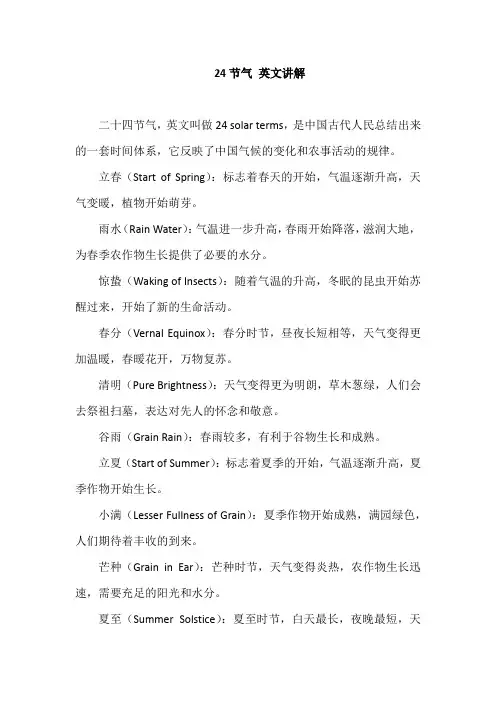
24节气英文讲解二十四节气,英文叫做24 solar terms,是中国古代人民总结出来的一套时间体系,它反映了中国气候的变化和农事活动的规律。
立春(Start of Spring):标志着春天的开始,气温逐渐升高,天气变暖,植物开始萌芽。
雨水(Rain Water):气温进一步升高,春雨开始降落,滋润大地,为春季农作物生长提供了必要的水分。
惊蛰(Waking of Insects):随着气温的升高,冬眠的昆虫开始苏醒过来,开始了新的生命活动。
春分(Vernal Equinox):春分时节,昼夜长短相等,天气变得更加温暖,春暖花开,万物复苏。
清明(Pure Brightness):天气变得更为明朗,草木葱绿,人们会去祭祖扫墓,表达对先人的怀念和敬意。
谷雨(Grain Rain):春雨较多,有利于谷物生长和成熟。
立夏(Start of Summer):标志着夏季的开始,气温逐渐升高,夏季作物开始生长。
小满(Lesser Fullness of Grain):夏季作物开始成熟,满园绿色,人们期待着丰收的到来。
芒种(Grain in Ear):芒种时节,天气变得炎热,农作物生长迅速,需要充足的阳光和水分。
夏至(Summer Solstice):夏至时节,白天最长,夜晚最短,天气最为炎热。
小暑(Lesser Heat):气温开始逐渐下降,天气变得较为炎热,但相较于夏至已经有所缓解。
大暑(Greater Heat):大暑时节,天气最为炎热,但也意味着夏季即将过去。
立秋(Start of Autumn):立秋时节,天气开始逐渐转凉,秋季作物开始生长。
处暑(End of Heat):处暑时节,炎热的天气已经过去,气温逐渐下降。
白露(White Dew):白露时节,天气变得更为凉爽,清晨和夜晚常常会形成雾气。
秋分(Autumnal Equinox):秋分时节,昼夜长短相等,天气变得更加凉爽。
寒露(Cold Dew):寒露时节,天气变得更为凉爽,秋季作物开始成熟。
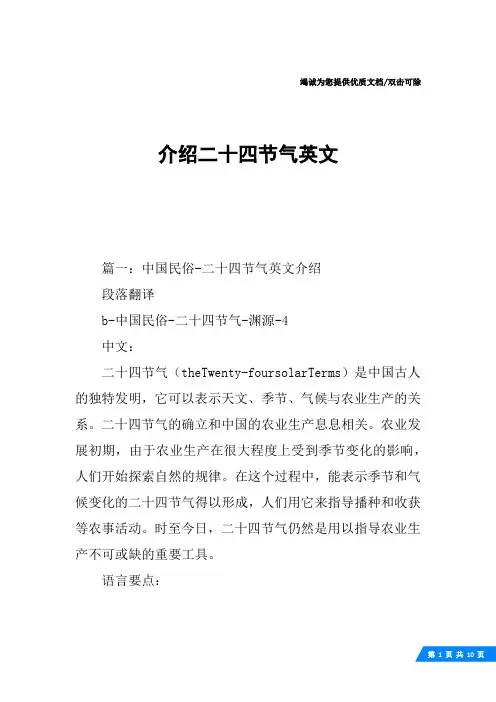
竭诚为您提供优质文档/双击可除介绍二十四节气英文篇一:中国民俗-二十四节气英文介绍段落翻译b-中国民俗-二十四节气-渊源-4中文:二十四节气(theTwenty-foursolarTerms)是中国古人的独特发明,它可以表示天文、季节、气候与农业生产的关系。
二十四节气的确立和中国的农业生产息息相关。
农业发展初期,由于农业生产在很大程度上受到季节变化的影响,人们开始探索自然的规律。
在这个过程中,能表示季节和气候变化的二十四节气得以形成,人们用它来指导播种和收获等农事活动。
时至今日,二十四节气仍然是用以指导农业生产不可或缺的重要工具。
语言要点:establishment;becloselyassociatedwith;attheinitials tageof;behighlysubjectto;comeintobeing;todate;funct ionas;indispensable译文:TheTwenty-foursolarTermsshowtherelationshipbetweent heuniverse,seasons,climateandagriculture,whichisaun iquecreationbychineseancestors.Itsestablishmentwasc loselyassociatedwithchineseagriculturalproduction.A ttheinitialstageofagriculturaldevelopment,peoplebeg antoexplorerulesofnaturesinceagriculturalproduction washighlysubjecttoseasonalchanges.Thus,theTwenty-fo ursolarTermsthatcanindicatethechangesofseasonsandcl imatecameintobeing,andtheywereusedtoguidesowing,har vestingandotheragriculturalactivities.Todate,ithasf unctionedasanindispensabletooltoguidetheagricultura lproductioninchina.篇二:二十四节气的英文表达立春thebeginningofspring(1stsolarterm)雨水Rainwater(2ndsolarterm)惊蛰thewakingofInsects(3rdsolarterm)春分thespringequinox(4thsolarterm)清明purebrightness(5thsolarterm)谷雨grainRain(6thsolarterm)立夏thebeginningofsummer(7thsolarterm)小满grainFull(8thsolarterm)芒种graininear(9thsolarterm)夏至thesummersolstice(10thsolarterm)小暑slightheat(11thsolarterm)大暑greatheat(12thsolarterm)立秋thebeginningofAutumn(13thsolarterm)处暑theLimitofheat(14thsolarterm)白露whiteDew(15thsolarterm)秋分theAutumnalequinox(16thsolarterm)寒露coldDew(17thsolarterm)霜降Frost′sdescent(18thsolarterm)立冬thebeginningofwinter(19thsolarterm)小雪slightsnow(20thsolarterm)大雪greatsnow(21stsolarterm)冬至thewintersolstice(22ndsolarterm)小寒slightcold(23rdsolarterm)大寒greatcold(24thsolarterm)篇三:24节气英语词汇二十四节气二十四节气The24solarTerms 立春springbegins.雨水Therains.惊蛰Insectsawaken.春分Vernalequinox清明clearandbright.谷雨grainrain.立夏summerbegins.小满grainbuds.芒种graininear.夏至summersolstice.小暑slightheat.大暑greatheat.立秋Autumnbegins.处暑stoppingtheheat.白露whitedews.秋分Autumnequinox.寒露colddews.霜降hoar-frostfalls.立冬winterbegins.小雪Lightsnow.大雪heavysnow.冬至wintersolstice.小寒slightcold.大寒greatcold城市的常见英语词汇centreofpopulation城市city城capital首都metropolis大都市centre市中心(美作:center) shoppingcentre商业区municipality市政当局municipal市的,市政的district区residentialarea居民区,住宅区urban市区的suburb近郊区outskirts郊区slums贫民窟,贫民区shantytown贫民区village村hamlet小村hole,dump狭小破旧的住房locality所在地chinesequarter唐人街extension范围,扩展house房子building楼房skyscraper摩天楼flat居住单元,套房shop,store商店departmentstores百货公司bazaar,bazaar市场market市场,集市junkshop旧货店newsstand报摊commodityexchange商品交易所stockexchange股票交易所townhall市政厅Lawcourt法院church教堂cathedral大教堂chapel小礼拜堂cemetery墓地,公墓grave,tomb坟,墓school学校university大学library图书馆theatre剧院(美作:theater) museum博物馆zoologicalgarden动物园fairground,funfair游乐园stadium体育场generalpostoffice邮局station车站artmuseum美术馆artgallery画廊botanicalgarden植物园monument纪念碑publictelephone公共电话publiclavatory公共厕所nationalhighway国道trafficlight交通灯barracks兵营标点符号和运算符号.period句号,comma逗号:colon冒号;semicolon分号!exclamation惊叹号?questionmark问号 ̄hyphen连字符apostrophe省略号;所有格符号—dash破折号??singlequotationmarks单引号“”doublequotationmarks双引号()parentheses圆括号[]squarebrackets方括号《》Frenchquotes法文引号;书名号...ellipsis省略号¨tandemcolon双点号"ditto同上‖parallel双线号/virgule斜线号&ampersand=and~swungdash代字号section;division分节号→arrow箭号;参见号+plus加号;正号-minus减号;负号±plusorminus正负号×ismultipliedby乘号÷isdividedby除号=isequalto等于号≠isnotequalto不等于号≡isequivalentto全等于号≌isequaltoorapproximatelyequalto等于或约等于号≈isapproximatelyequalto约等于号<islessthan小于号>ismorethan大于号≮isnotlessthan不小于号≯isnotmorethan不大于号≤islessthanorequalto小于或等于号≥ismorethanorequalto大于或等于号%percent百分之…‰permill千分之…∞infinity无限大号∝variesas与…成比例√(square)root平方根∵since;because因为∴hence所以∷equals,as(proportion)等于,成比例∠angle角?semicircle半圆?circle圆○circumference圆周πpi圆周率△triangle三角形?perpendicularto垂直于∪unionof并,合集∩intersectionof交,通集∫theintegralof…的积分∑(sigma)summationof总和°degree度′minute分″second秒#number…号℃celsiussystem摄氏度@at单价。
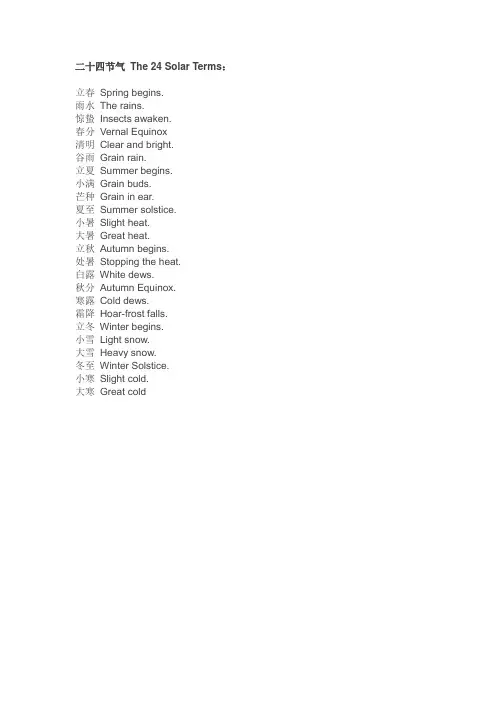
二十四节气The 24 Solar Terms:立春Spring begins.雨水The rains.惊蛰Insects awaken.春分Vernal Equinox清明Clear and bright.谷雨Grain rain.立夏Summer begins.小满Grain buds.芒种Grain in ear.夏至Summer solstice.小暑Slight heat.大暑Great heat.立秋Autumn begins.处暑Stopping the heat.白露White dews.秋分Autumn Equinox.寒露Cold dews.霜降Hoar-frost falls.立冬Winter begins.小雪Light snow.大雪Heavy snow.冬至Winter Solstice.小寒Slight cold.大寒Great cold以下无正文仅供个人用于学习、研究;不得用于商业用途。
For personal use only in study and research; not for commercial use.仅供个人用于学习、研究;不得用于商业用途。
Nur für den persönlichen für Studien, Forschung, zu kommerziellen Zwecken verwendet werden.Pour l 'étude et la recherche uniquement à des fins personnelles; pas à des fins commerciales.仅供个人用于学习、研究;不得用于商业用途。
толькодля людей, которые используются для обучения, исследований и не должны использоваться в коммерческих целях.For personal use only in study and research; not for commercial use。

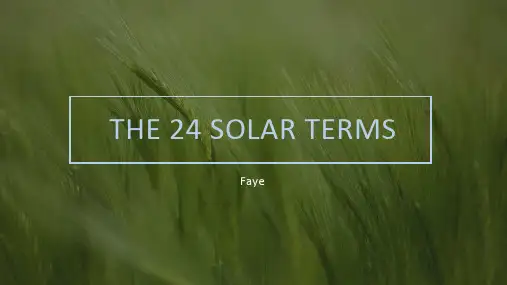
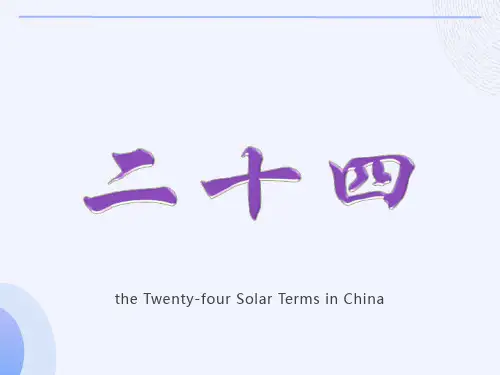
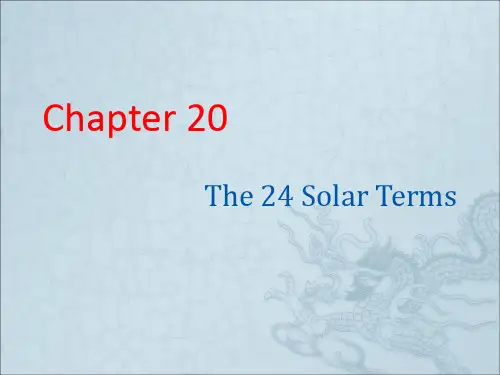
中国24节气英语介绍The 24 Solar Terms of China (中国24节气) are a unique cultural phenomenon that reflects the changing seasons and weather patterns throughout the year. These terms are based on the ancient Chinese lunisolar calendar and have been used for thousands of years to guide agricultural activities, festivals, and traditional Chinese medicine.1. Spring Begins (立春): This marks the beginning of spring when the weather starts to warm up, and plants begin to grow.2. Rain Water (雨水): As the name suggests, this term signifies the increasing amount of rainfall as winter transitions into spring.3. Awakening of Insects (惊蛰): During this term, insects and dormant animals start to come out of hibernation, and nature becomes more lively.4. Spring Equinox (春分): On this day, the length of day and night is equal. It symbolizes the arrival of spring's fullness.5. Pure Brightness (清明): This term is associated with the Qingming Festival, where people pay respects to their ancestors and enjoy theoutdoors as the weather becomes clearer and warmer.6. Grain Rain (谷雨): This term signifies the arrival of the rainy season, which is beneficial for the growth of grain crops.7. Summer Begins (立夏): As the temperature rises, summer officially begins, and crops continue to flourish.8. Grain Buds (小满): At this time, crops start to grow and form small seedlings or buds.9. Grain in Ear (芒种): This term indicates the maturity of the grain crops as they start to form ears.10. Summer Solstice (夏至): On this day, the sun reaches its highest point in the sky, making it the longest day of the year.11. Slight Heat (小暑): The hot weather gradually intensifies, and people must adapt to the rising temperatures.12. Great Heat (大暑): This term represents the hottest time of the year, and people take precautions to beat the summer heat.13. Autumn Begins (立秋): As the heat subsides, autumn begins, and people prepare for the upcoming harvest season.14. The Limit of Heat (处暑): The weather starts to cool down, and the hottest days of summer pass.15. White Dew (白露): Dewdrops become more visible as the temperature drops, and mornings become cooler with the arrival of autumn.16. Autumn Equinox (秋分): Similar to the spring equinox, the length of day and night is equal during this time. It signifies the balance between light and darkness.17. Cold Dew (寒露): The temperature drops further, and the environment becomes colder as winter approaches.18. Frost's Descent (霜降): Frost starts appearing, indicating that winter is drawing near, and it is time to protect crops.19. Winter Begins (立冬): Winter officially starts, and the weather becomes noticeably colder.20. Slight Snow (小雪): Snowfall becomes more frequent, but it is usually light and not significant.21. Great Snow (大雪): Snowfall becomes heavier, and the weather becomes colder, hinting at the approaching winter.22. Winter Solstice (冬至): This day has the shortest daylight hours of the year, marking the longest night and the arrival of winter's peak.23. Slight Cold (小寒): The coldest days of winter pass, but the weather remains chilly.24. Great Cold (大寒): The last of the 24 terms, this is the coldest time of the year, with low temperatures and cold winds blowing.The 24 Solar Terms are not only used for agriculture but also influence Chinese festivals, traditional customs, and even daily life, as they provide guidance for people to adapt to the changing seasons.。
春雨惊春清谷天
立春 the Beginning of Spring (春季的开始) 雨水 Rain Water(雨水量渐增)
惊蛰 the Waking of Insects(唤醒冬眠的动物) 春分 the Spring Equinox(昼夜平分)
清明 Pure Brightness(天气晴朗,草木繁茂)
谷雨 Grain Rain(雨量充足谷类能茁壮成长)
夏满芒夏暑相连
立夏 the Beginning of Summer(夏季的开始) 小满 Grain Full(麦类等夏熟作物籽粒开始饱满) 芒种 Grain in Ear(有芒麦类作物成熟)
夏至 the Summer Solstice(白天最长)
小暑 Slight Heat(气候开始炎热)
大暑 Great Heat(一年中最热的时刻)
秋处露秋寒霜降
立秋 the Beginning of Autumn(秋季的开始) 处暑 the Limit of Heat(炎热的暑天结束了) 白露 White Dew(天气转凉,露凝而白)
秋分 the Autumnal Equinox(昼夜平分)
寒露 Cold Dew(露水以寒)
霜降 Frost's Descent(天气渐冷,开始有霜)
冬雪雪冬小大寒
立冬 the Beginning of Winter(冬季的开始) 小雪 Slight Snow(开始下雪)
大雪 Great Snow(雪量增多,地面积雪)
冬至 the Winter Solstice(夜晚最长)
小寒 Slight Cold(天气开始寒冷)
大寒 Great Cold(一年中最冷的时刻)。